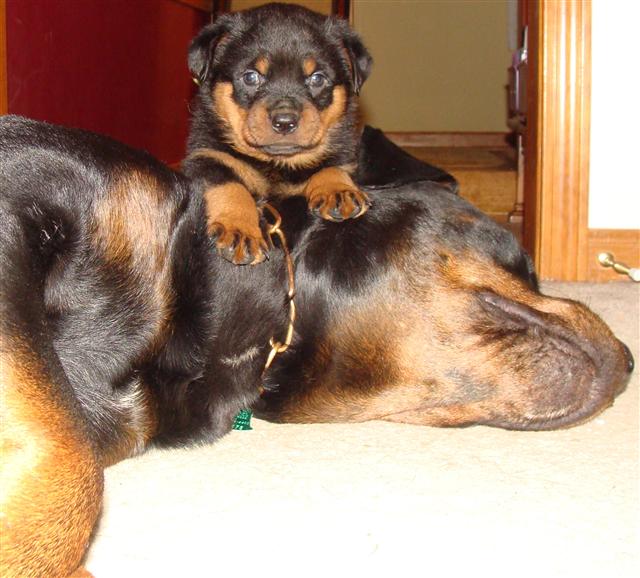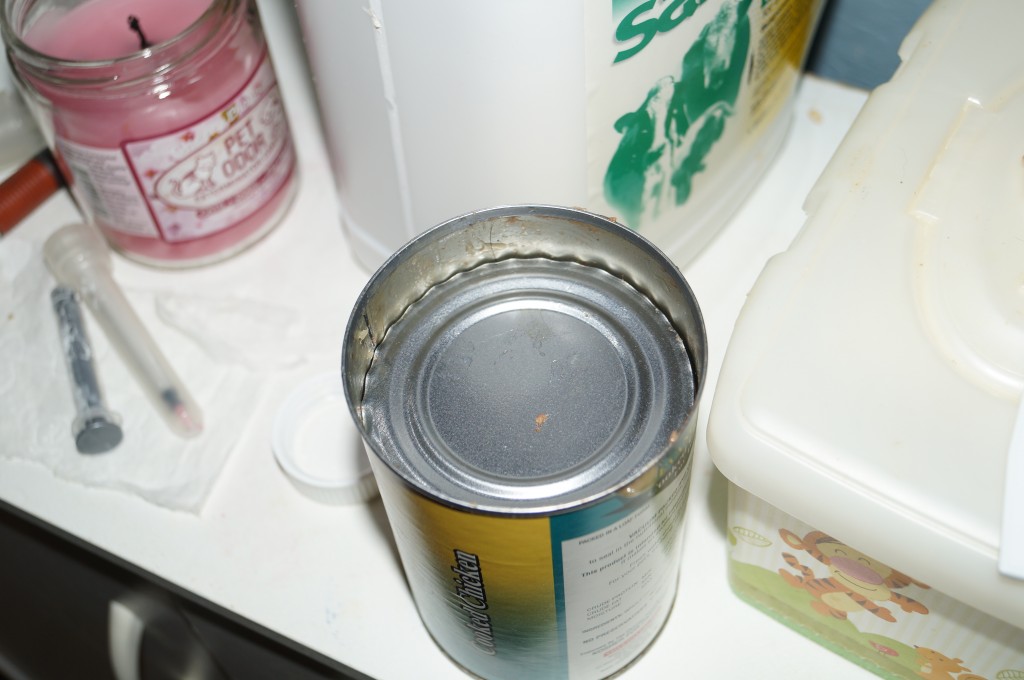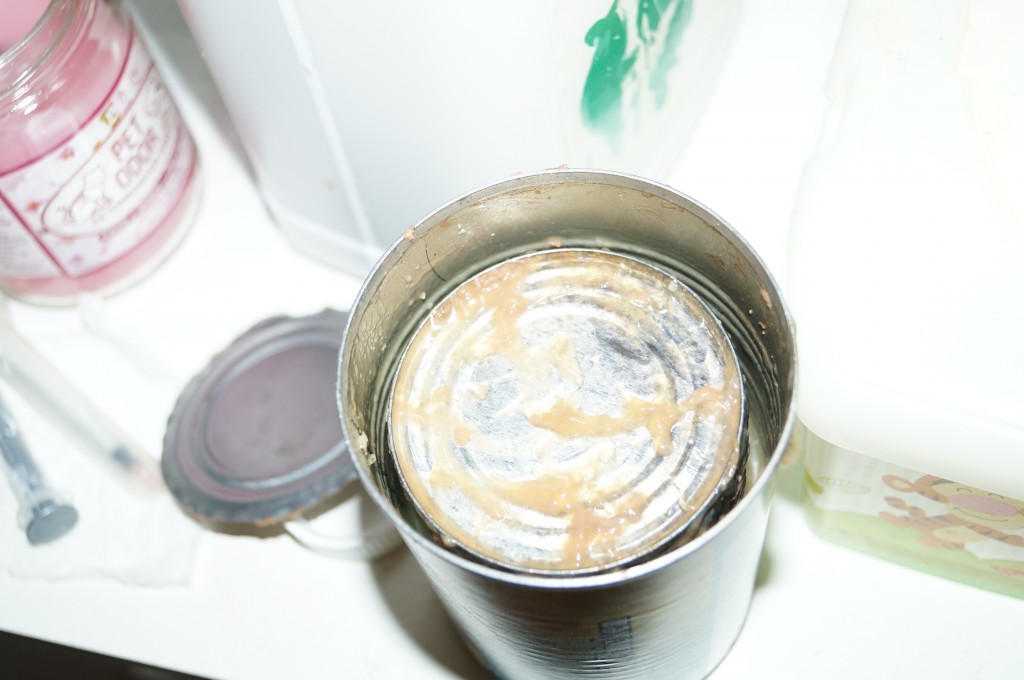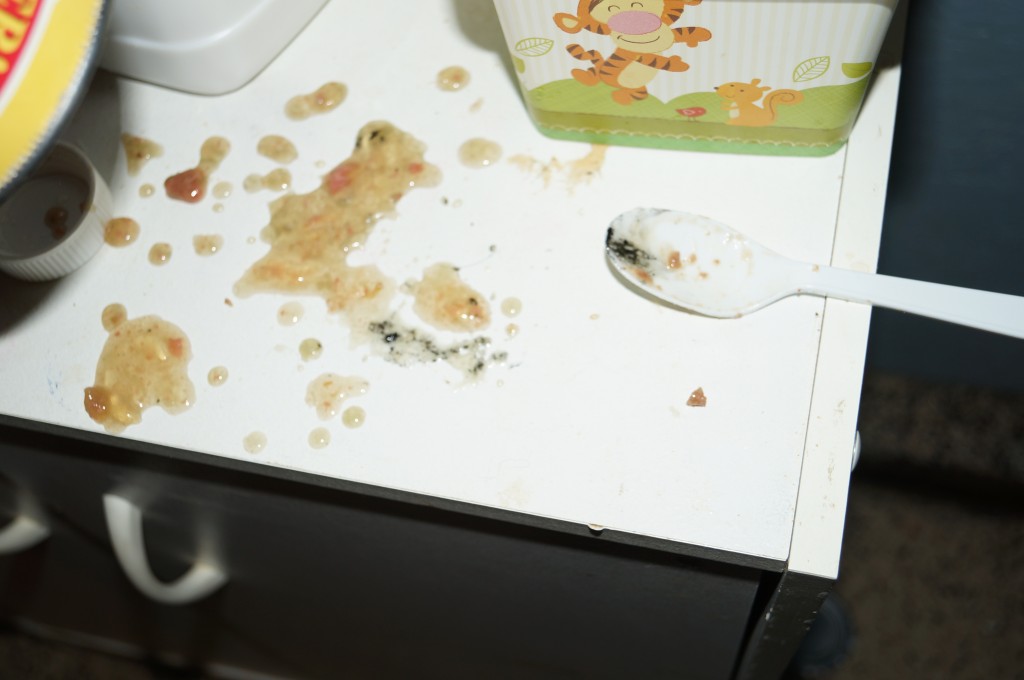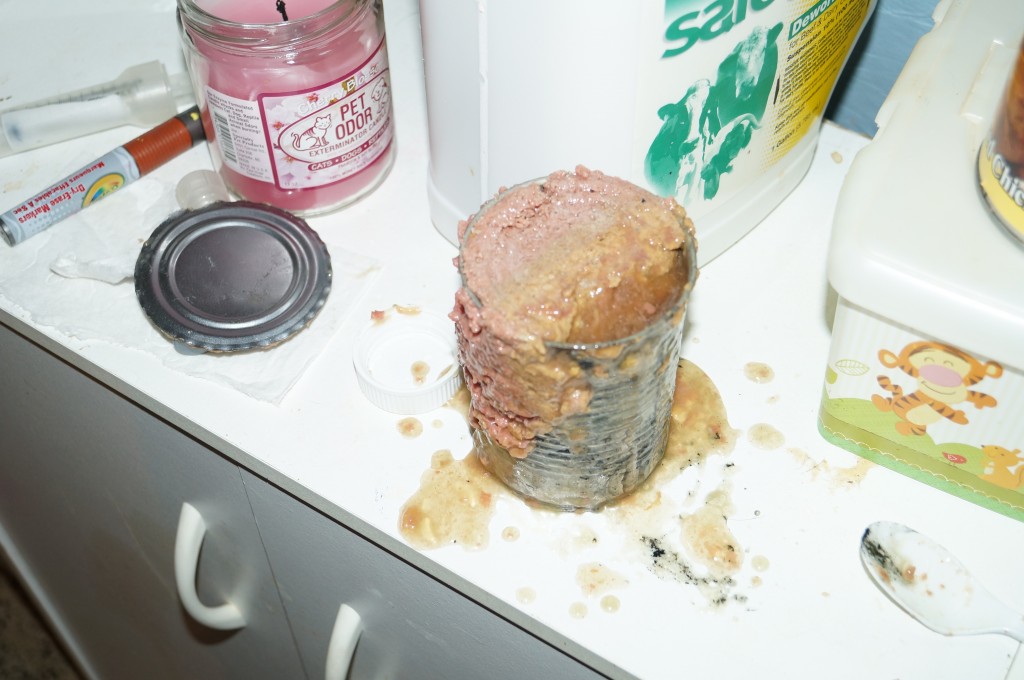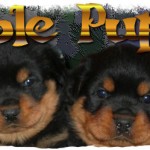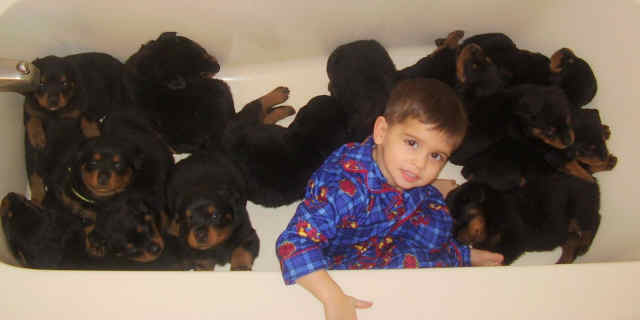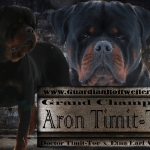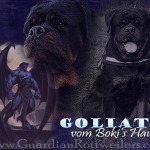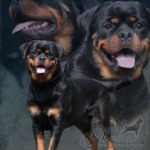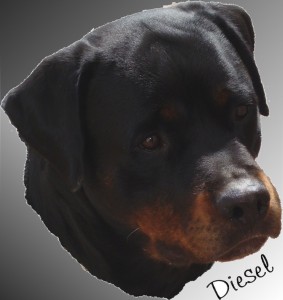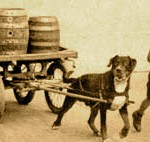Nutrition
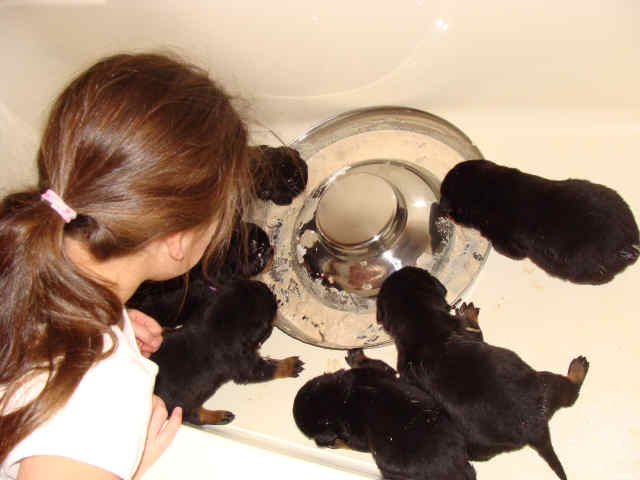
We are asked daily both by Rottie owners and by owners of other breeders about canine nutrition. Here at Guardian Rottweilers, we take choosing the correct food for our dogs and puppies very seriously. Nutrition is very important for any breed or species, but especially crucial in large breed dogs. A Rottweiler will grow from less than a pound at birth to 80-100+ pounds in the very short space of 12 months. This is one of the greatest contributors to many of the joint problems that plague Rottweilers, especially hip and elbow dysplasia. It is very important that you have a genetically strong dog/ bloodlines to help prevent hip and elbow dysplasia, but the dogs diet also plays a major role. It is important that the puppy have a diet that is high in glucosamine and chondroitin to help protect the joints, and equally important that the diet have an easy to digest protein source that is in correct balance to ensure a fluid growth rather that huge growth spurts that can be damaging not only to the joints, but also to large muscles including the heart.
We have tried MANY foods over that last decade, and have found that there are a few out there that are of merit, but unfortunately, many that are far from adequate. I have also found that popularity or price often have little to do with the quality of the food. Many of the more popular or more well known brands (Eukanuba, Purina, etc.) are often popular only because of aggressive marketing, sponsoring loads of dog shows, and offering big incentives to breeders, handlers, trainers and veterinarians to use and recommend their products.
I will try to break down the things that I have learned to look for in good dog food to include or exclude, through my research and by trial and error. I would never assume to tell anyone what to feed their dog. I am not a veterinarian or a nutritionist. I am simply a breeder and owner who loves her dogs and has put nearly 2 decades of my life into trying to find the best for my babies. The information found here is not shaded based on incentives or kick-backs and I have nothing to gain by recommending or not recommending any brand or company. I have found that good, honest, no bias information on canine nutrition is nearly impossible to find. The information on this page will evolve as my knowledge and experience grows, just as what I feed my own pack is constantly evolving with the ever changing medical and clinical research. Any professional in any field that ever thinks they “know it all” is not fooling anyone other than themselves. I always welcome input and and always willing to learn new ways to be and do better for my dogs. They are my heart and soul and finding the best nutrition for them is just as important for me as finding the best for my own kids.
I hear all the time from owner that they use inferior brands because “my dog loves it.” My response has always been, well, I LOVE Doritos but that does not mean that my diet should consist of corn, salt, sugar and added flavor.
Order of ingredients. The order of ingredients in a bag of dog food is in order of weight, heaviest first. Thus, the number one ingredient should be the biggest ingredient in the dog food. You want, at bare minimum, 3 of the first 5 ingredients to be animal sources (chicken, duck, salmon, rabbit, beef, etc.). Be aware, however, that dog food companies will do everything they can to cheat the system including using the weight of a wet meat (like beef) before it is dehydrated and the weight of grains that are dehydrated, so that weight wise, initially, the meat is heavier than the grain even though, in reality, once the water is removed from the meat, there is waaaay more grain than meat in the bag of food with the meat not even making the top 5 ingredients. The number one ingredient should NEVER be anything other than meat as dogs are carnivores. With problematic ingredients (peas, corn, wheat, legumes, etc.), the higher up on the label, the more (quantity) there are of those ingredients and higher propensity for problems.
Now, lets go over what to EXCLUDE.
Corn, wheat and soy are the most common allergens in dog food. Because they are all dirt cheap, they are used prolifically despite common knowledge of chronic issues including ear infections, digestive issues and skin problems- ranging from dry skin all the way to serious hot spots that can cause permanent scaring and damage. Sadly, the price of a bag of food and even recommendations from a “reliable” source like a pet store, trainer or veterinarian is not conclusively synonymous with quality.
One of the most prolific allergens among Rottweilers (both skin and digestive) is wheat. There is no need for wheat in dog or cat food. However, because it is cheap and can also falsely boost protein levels, it is common in low-grade dog foods. The gluten protein contained in wheat damages the lining of the small intestines, preventing proper absorption of food and vital nutrients. Both dogs and cats are obligate carnivores with digestive systems geared towards digesting meat, not grains. Bottom line, avoid any food or treat that contains wheat and do not give “table food” that contains wheat.
Another controversial ingredient is corn. I have read and had explained to me by vets, manufacturers and other breeders arguments for why corn is ok in dog food- mostly, that it is a good source of carbohydrates/energy. To the best of my understanding, whether or not it poses any nutritional value at all as opposed to being just a filler may have to do with how it is processed and the quality of the corn. A filler is an ingredient that provides little to no nutritional value, but just “fills” the bag up. Dogs are not designed to digest corn, hard grains and vegetables. Filling pet foods with ingredients such as cheap corn can cause digestive upset and even blockages. Because of the higher sugar content in corn, it can also contribute to diabetes and obesity. Allergic reactions to corn include eye swelling, chronic and sometimes severe ear infections, dry or dull coat, skin issues ranging from itching to open skin lesions and hot spots, obsessive licking of the feet, and hyperactivity. Unfortunately, as it is another cheap, easy ingredient, despite such a high occurrence of allergies, it used often in low-grade dog foods. Even if a high enough quality of corn processed the right way did yield some carbohydrates, there are much better sources that the potential benefits are vastly overshadowed by the potential health issues. Food with corn should be avoided.
Soy. Soybeans are a legume. Soy is used in many popular vegetarian products including tofu, soymilk, and other meat and cheese substitutes. Soy extracts, like soy lecithin and emulsifiers, are commonly added to processed foods. So why is soy used in dog and cat food? Consumers have learned to look for high protein levels in a pet food. Unfortunately soy and other legumes are a much cheaper alternative protein than actual meat. By adding soy, garbanzo beans, pea protein, and other legumes, dog food manufacturers can increase the protein level without sufficient animal content. Aside from the fact that canine digest systems are not designed to adequately process most vegetables and legumes, lack of proper amounts of actual animal protein (poultry, beef, fish, etc.) can cause catastrophic problems for cats/dogs over time. In addition to being a cheap, but nutritionally useless filler in pet foods, there are some more significant reasons to avoid soy in pet food.
Legumes, including soy, have proteins called lectins. Lectins bind to carbohydrates and interfere with digestive enzymes. This blocks your dog’s absorption of important vitamins and minerals. In addition to diet deficiencies, this can cause digestive issues like bloating, gas and diarrhea. Further, the damage caused by lectins can lead to leaky gut syndrome. Leaky gut can cause many chronic health problems including allergies, arthritis and autoimmune disease. A 2018 international study found that soybean agglutinin ” … negatively affects intestinal structure, intestinal permeability, mucosal immune system, and intestinal flora.”
Another serious issue with soy is the glyphosate. Nearly all soybean crops in the US are genetically modified. All GMO foods have a high level of glyphosate (Roundup weed killer). Aside from the obvious of not wanting your dog to consume Roundup weed killer, it destroys the good bacteria in your dog’s gut. Since the immune system starts in the digestive system, this means your dog’s immune system is also weakened. Not surprisingly, glyphosate is also a carcinogen (causes cancer). GMOs are also known to increase bacteria that are antibiotic resistant.
Studies have also linked soy to hypothyroidism (lower thyroid function) in dogs by interfering with the thyroid gland’s ability to make T4 (thyroxine) and T3 (tri-iodothyronine). The thyroid gland is essential for proper function of every cell in the body. It makes and stores hormones that help regulate body temperature, heart rate blood pressure and the conversion of food into energy.
Soy is also high in phytoestrogens- known to cause everything from infertility to polycystic ovarian syndrome and even breast cancer in humans. They have also been linked to an increased risk of dementia.
Soy is also one of the most common allergens in dogs. Sadly, this is not new news. In a report from UK’s York Laboratory in 1999, researchers found that allergic reactions to soy had risen by 50% from the previous year and were continuing to trend upward. How dog/cat food manufactures can still get away with using it nearly a quarter of a century later is beyond me. Although most health issues caused by soy may take some time to become problematic for your pet, some issues, such as seizures and allergic reactions can present early in use of food containing soy.
By Products. We are all educated to avoid by-products. But what exactly is a by-product? Plain and simple, by products are the products left over after any “usable for human consumption” parts have been removed. By products are a non-specific term and can mean anything from feathers, intestine, skin, feet, bills, etc. to even scarier items such as parasite and disease infested tissue, tumors, etc. In other words, stuff that I really don’t want to eat, much less, feed my best friend. Also, if the meat source is not specifically identified (i.e. if it says “poultry” instead of chicken/duck/turkey/etc. or “meat” instead of beef or venison) then I avoid it as well. I am sure you would not feed your family some random “meat” without knowing what it came from and where. Even scarier, meat that was not stored properly and is therefore unsafe for human consumption can be used in dog food.
“By-products that are not refrigerated immediately after slaughter but stored for hours in a hot offal trailer cannot be sold for human consumption… can still be legally used for making pet food.”
“Rejected waste such as dead farm and zoo animals that have been declared unfit for human consumption can first be rendered into meal ingredients… And then be used to make pet food.”
Have you ever wondered why there are so many recalls for e.coli and salmonella and other food poisoning pathogens from dog food?
Even worse are the dog foods that contain non-specific “by-product meal” because then you truly have no idea what animal the ‘meal’ is even coming from. It can LEGALLY include:
- Road kill
- Dead zoo animals
- Dead on arrival poultry (having no idea what the bird died from and how it may affect your pet)
- Diseased and dying livestock
- Euthanized dogs and cats (unlikely today, but still possible)
Rendering. What does ‘rendering’ mean? Rendering is a process where the “food’ (helper bunny ear quotes because I have no idea who would consider that food…) is boiled and intentionally overcooked. The whole mess is cooked until all the water is cooked out. Then the fat is skimmed off and the residue is baked and turned into powder that is called ‘by-product meal.’ Sound delicious??
Fillers. The term “fillers” is another very ambiguous term used often in what to avoid. A filler is just that- an ingredient added that is inexpensive and used mostly to just fill the dog food bag up. Fillers have little to no nutritional value and should also be avoided. A dog food that is higher in fillers will require a dog to eat several times as much to get half the nutrition it requires. And of course, if a dog is eating 2-3 times more, guess what else he is doing 2-3 times as often in your back yard. I have often explained it like this: We have all been to a Chinese buffet where we eat like 3 plates of food- way more than we should 😉 and we think we are absolutely stuffed when we walk away. However, in about 2 hours, we are hungry again- after we just ate more than we should have for the whole day! Why is this? Because we filled up on “fillers”, empty carbohydrates with little nutritive value leaving the body still un-sustained. Conversely, if you were to sit down with a porterhouse steak, you would be full for the whole day even if, volume wise, you consumed far less than you 3 plates at the Chinese buffet. Your body was able to use most of what you consumed, or, as my grandma used to say, “it stuck to your ribs.”

Ok, we have looked at what to stay away from, so what should we look for the food to contain?
Dogs are carnivores so ideally, you want 3 of the top 5 ingredients, at bare minimum, to be a specific meat source- i.e. chicken, duck, lamb, venison, etc. And if one or more of the meat products is a “meal” (i.e. chicken meal, duck meal, lamb meal, etc.) it will actually have a higher level of protein (up to 300%!) than the actual meat (chicken, lamb, etc.) The products are listed on the label in order of weight. Dog food companies get around this by putting the wait of the meat before cooking/dehydrating, leaving a fraction of the actual weight of the meat the label would suggest. Once the moisture is cooked out, the amount of actual chicken, lamb, beef, etc. in the dog food is significantly less and therefore the amount of actual protein also. Meal, on the other hand, is already in concentrated form with most of the moisture removed, so it is much more accurate in volume and weight. I prefer to see both on the dog food label- both the meal so that I know I really am getting enough animal protein, and the meat (chicken, duck, lamb, etc.) so that I know my dog is getting enough of the actual animal.
PROTEIN LEVELS, FATS, CALCIUM, PHOSPHORUS Once upon a time, all of the nutrition research for large breed dogs said that protein levels were extremely important in growing large breed dogs. What we did not realize is that the reason protein had such a significant impact on proper development was because of how it effected the calcium and phosphorus ratios. Unlike adults, puppies do not adequately regulate calcium absorption. Although we all know that calcium is vital for strong bones, an excess of calcium can lead to bone developmental issues. The ideal calcium: phosphorus levels are 1:1 to 2:1 Fat levels are also important. If the diet is too rich in fat, then the puppy can grow faster than his skeletal development can accommodate. About half of the calories a puppy consumes goes directly towards skeletal development and tissue growth. It is vital that the calories your puppy does consume are nutrient dense and in balance. You do NOT want your Large Breed Puppy growing too quickly! Excess protein and fat in your large breed puppy’s diet not only causes huge growth spurts that can cause bone and joint damage, but can overall detrimental effects on growth and development. Too much protein, fat or calcium can be a huge contributing factor for hip and elbow dysplasia as well as other joint issues such as FCP, HOD, and OCD.
Salmon or Salmon Oil. Rottweilers are a breed that tends to suffer more from dry skin. Having enough Omega 3’s like those found in salmon and salmon oil are essential to a healthy, shiny coat and good skin. We add salmon oil regularly to our dogs diet especially when they are being shown or are working.
Pre and Probiotics. I also look for a food that contains prebiotics and probiotics (Live bacteria cultures like those found in yogurt). You see them a lot in the media finally getting recognized for their effective aid in improving digestion, well, they work for our beloved canines and felines also. And if anyone needs help with digestion and settling upset tummies I would think it to be those who drink out of the toilet bowl, lick their bums, and pick-up everything in the yard :)’ We travel a lot with our dogs and digestive inconsistencies can occur when going over seas or after competitions. I love to see a dog food that takes an active step in helping prevent that.
Finally, I look for a food that has a specified amount of glucosamine and chondroitin, and a food that has a specific Large Breed Puppy formula up until 2 years of age. As stated above, large breed dogs like the Rottweiler really need to eat a dog food that not only has the necessary vitamins and minerals to promote healthy growth, but it is also essential that they be on a food that has the correct balance of proteins so that they have an even, steady growth rather than large growth spurts. Be warned, not all “large breed puppy” formulas are really formulated for large breed puppies!! Some dog food companies simply market it as a large breed puppy formula without really taking the steps to ensure the food is what a growing large or giant breed puppy needs. They call this “clever marketing.” A true “large breed puppy” formula will be lower in protein and fat and have a specified level of calcium, glucosamine and chondroitin. Also beware of “puppy” formulas as these are the worst thing you can feed a large breed puppy. “Puppy” formulas and “Large Breed Puppy” foods should be quite different from one another as “puppy” foods are typically formulated for small puppies who will have very different nutritional requirements than large breed puppies, and are often way too high in protein and fat for large breed dogs.
Also be aware of protein sources. Many cheap dog foods will use very low quality protein sources so that they can claim to have a certain protein level. Corn gluten, soy, pea protein, and poor quality meats (like by products) will raise the protein level of the food but are difficult for the dog to digest so are largely unusable to your dog.
We currently feed our dogs RAW. I like a rotational diet where the dog is not fed the same food day in and day out. It is nearly impossible for one food to have everything needed- poultry will be naturally higher in glucosamine and chondroitin; red meat will be naturally higher in iron and other essential vitamins; salmon and other fish will be naturally lower in fat and higher in omega 3’s and 6’s. Fish is also considered one of the easiest protein sources to digest. It is important to note that just like there is no one diet that works for all humans, not all dog food will work the same for all dogs and breeds. Individual dogs will have different nutritional requirements, and you will have to adjust what you feed accordingly. The information provided on this page is for educational purposes only and should never take the place of vet recommendations or you dog’s specific needs.
Although we NO LONGER feed kibble (dog food) here are some foods we have tried, years ago, and liked:
• Darford is another brand that I really like and have a lot of respect for. I love their Zero G line of treats and food. Darford is made by our neighbors to the north (Canada) and my dogs loved it.
• Redpaw. A good friend of mine who is a breeder in Canada turned me on to this product a nearly 2 decades ago and I am so excited it is finally available here in the US with greater regularity. Redpaw was initially made for sled dogs and is high in quality protein. It is great for dogs that are very active and hard to keep weight on. We have also used it for our pregnant and lactating bitches as it offers higher protein and fat levels which are essential when nursing fat puppies!
• Addiction. This product is manufactured in New Zealand and we LOVE it! “Little Bit” (Jahzara) was born premature and was a picky eater. She LOVES raw food, but is not a big fan of kibble. We started her on their Raw Dehydrated Food to supplement her raw diet and she wolfs it down (pun intended! :D). This food is a little pricey, but if you have a picky eater, or do not have an entire herd to support and the price tag is doable, it is worth considering.
• Merrick. Merrick is another great product, we especially like their “Before Grain.”
• Pet Curean. Another food that I have heard great things about. I love their NOW! Grain Free products, for adults.
• Also liked Innova, Evo (Evo Red Meat is excellent for a very active dog or one with a high metabolism like our Dunjo). We used Evo Red Meat before we switched to RedPaw for our dogs that had higher protein and fat requirements and really liked it.
• Instinct Raw Boost. This is a newer food that we researched for a client. I like the concept and the ingredients seem very good quality. They also have some pre-made raw that you can find in the refrigerated/freezer section at your pet store which also makes them a nice option if you are interested in raw, but not confident on making your own.
• Stella & Chewy’s. They have a nice range of raw coated kibble, freeze dried food, raw dehydrated food, and even treats and wet food.
• Billy & Margot. Tried this brand on a couple of pups the owners wanted us to switch from raw to kibble before they went to their new homes. The pups thought it was delicious and I love the quality ingredients. Nice array from kibble to frozen, and even some kangaroo!
• Honest Kitchen. I have not tried this brand yet, but have several clients and friends who use it and love it. It can be a good alternative making your own raw, or it can help supplement what you are feeding.
As with anything in life, price and popularity DO NOT EQUAL quality!! Some popular foods (Royal Canin, Eukanuba, Purina, Victor, etc.) that are used and recommended by some breeders, trainers and even veterinarians are popular because they have great kick-backs and incentives for those that push their products. Because the companies spend a great deal of money on marketing, sponsoring dog shows, and of course the kick-backs, the food is way over priced for the quality- as much as or even more than foods with quality ingredients. But if you look at the ingredients, there is no place to hide. Most of the cheap/crap brands will have chicken-by-product as their main or even sole protein source. As previously discussed, to be clear, by-product is the unusable scraps left over when any eatable meat is taken from the animal’s carcass and does not exclude diseased or infested bits to include tumors. Another way to spot a cheap quality food is when it contains corn, wheat or soy. Not only are these the most common dog food allergens, but because they offer little to no nutritional value, you are paying for as much as 60-80+% of a bag of food to be a cheap filler! We have known for decades the degree of issues caused by allergies to these ingredients so there is really no excuse for selling foods that still contain them. Some of these dog foods have about the same nutritional value for a dog as a bag of bird food (and some are essentially nutritionally just that, ground bird food!). What you feed matters! ESPECIALLY during the first 2 years! It can have the single greatest impact on how your dog grows. This indisputable fact is why we have what you feed included in our GR Puppy Contract and why failing to feed quality food voids our guarantee. My job as a breed does not stop at choosing quality bloodines and making sure all health clearances are completed. Without proper education of puppy owners and insisting on proper care and nutrition, all the careful breeding and thousands in breed suitability testing is fundamentally negated. It would be the same as parents carefully screening their unborn child for all known genetic issues and then raising the child almost exclusively on Doritos- any good grace you have earned with superior genetics is vitiated by poor nutrition and the doors for all the health issues that were so carefully screened against are flung wide open. We understand how paramount proper nutrition is for a growing human child that can take 18-30 years to fully develop mentally and physically. Imagine how much more critical it is when that growth and development is set on fast-forward. A Rottweiler puppy will grow as much as 100x his birth weight in as little as 12 months!! That is the human equivalent of an infant that starts out weighing 8 pounds reaching a staggering 800 pounds by we months of age!! If you are going to splurge on one thing for your Rottweiler, make it good quality food and take the time to really know what you are feeding your best friend!
Foods that did not work out as well for us:
• FROMM. I fed FROMM for several years, but after some inconsistency and integrity issues with my representative of their company, decided it was not a good food for my fur-babies. I will never feed my kids, 2 or 4 legged, something I cannot trust, and if I cannot trust the company, it does not matter how good the food is. After some pretty significant allergies were reported from clients after starting a new bag (even though they had been using FROMM for months or years) as well as too many reports of digestive upset to be ignored, reaching out to my representative for the company proved to be equally inconsistent. We NO LONGER recommend FROMM.
• We used Royal Canin for some time when we first started breeding, and I loved the “Baby Dog” formula for puppies trying solid for the first time. However, the more I learned about canine nutrition, the more I realized it was not the food for me. Love the high levels of glucosamine and chondroitin and general quality of their ingredients, but wish they had a corn free and wheat free formula. I also do not like that the “Rottie” formula has all 3 of the top allergens for this breed in it.
• Canidae. Canidae is another solid food, but, because all of the grain free formula’s are made my Diamond, I would be very cautious with it.
• Life’s Abundance (this holistic dog food is shipped right to your door and is free from many of the preservative that other manufactures have to use. I wish that they had a Large Breed Puppy formula and that they had specified levels of glucosamine and chondroitin, but other than that, decent ingredient list. This is a popular dog food with many breeders because they offer a lot of incentives and kick-backs, however, for my pack, it was just not enough of the quality nutrients they needed. I really wanted to love this product as much as my wallet did, but some had dull coats and/or dry skin, and really struggled to keep weight on the workers.
• Solid Gold. We tried Solid Gold and our pack found it pretty palatable with no significant digestive upset or allergies. However, Diamond Pet Foods manufactures four Solid Gold dry dog foods: WolfKing, WolfCub, Just a Wee Bit, and Hund-n-Flocken. All WolfKing, WolfCub, Just a Wee Bit, and Hund-n-Flocken sold in the United States are made in the Diamond Pet Foods plant in Meta, Missouri. Because of all the issues Diamond dog food has had across the board, I cannot recommend Solid Gold. I updated my research on this food as we have not tried it or looked it up in well over a decade, and I found this on pawdiet.com:
“In the early 2000s, most Solid Gold pet foods were manufactured by Diamond Pet Foods. Today, only a few recipes are manufactured by Diamond.” Again, because of my significant distrust of Diamond, I recommend proceeding with caution if you choose to use this food. Watch for any inconsistencies in the food from back to back and be aware of any changes in your dog’s behavior, stool or overall health.
• Hills Science Diet. Yes, I am aware that it is recommended by many veterinarians, just like Royal Canin. Bear in mind that nutrition classes for veterinarians are taught by, you guessed it, dog food manufacturers. Most veterinarians are just regurgitating what they were spoon fed and do not have the experience a breeder who has raised dozens, if not hundreds of dogs from birth to death, often for many generations. Many problems with this dog food including no probiotics and calcium/phosphorous levels that are not ideal for proper bone/joint development in growing large breed dogs. However, the biggest problem is that this food does not contain one of the top 3 allergens, it contains all 3 of them! Only 1 of the top 5 ingredients is meat and wheat and corn are both in the top 5 ingredients and there is more than one form of soy as well :/ Altogether, just a very poor dog food. Although we have never used this dog food, it would have to be a zombie apocalypse with nothing else to feed my dogs before I would even consider using it.
AVOID LIKE THE PLAGUE:
Diamond. Anything Diamond- which includes Taste of the Wild. Because Diamond has had so much bad press from the numerous recalls and dog deaths, they tried to re-market themselves as Taste Of The Wild (TOTW), but do not be fooled- this is still Diamond and carries the same risks.
Evangers. Found this food at a Pet Expo in Illinois and thought it look super. Loved that everything was made right here in the good ol US of A. Ordered a bunch to try on my pack. Biggest mistake I ever made!! I will post photos of the rotten can inside of a can that my daughter found. This dog food not only made 2 litters of my puppies gravely ill- it took them WEEKS to recover! but unfortunately also claimed the lives of 3 of my babies. We sent one of the babies to Purdue for a Necropsy (Autopsy)- no parasite, negative for all viral cultures, no other problems other than complications associated with e.coli and salmonella poisoning! Evangers offered to replace the dozens of cases we pitched- NO THANKS!! I will NEVER touch ANYTHING Evangers EVER again!!
My kids helped me pitch everything we had on the shelves- about $3200.00 worth of food- but of course, even with a a dozen extra zeros added onto the price tag, still no where near worth the risk!! As Tahlia went to chuck one of the cans into the trash, it made a ‘clink’ noise. Curious, she opened it. When my daughter opened the large can of their Chicken formula, there was a very nasty, foul smell coming out of the can and the lid dropped down into the can about a half an inch. When she fished the lid out, there was a layer of black goo and under that another unsealed can of rotten food :/ SOOOO gross!!!!! Speaks volumes to quality control as the 2 cans of food were not even the same food and should have been processed in different parts of the factory, so how did it get in there?? If you could only have smelled the nauseating order that fill the entire building!! It was absolutely awful!
!!IMPORTANT!!
I cannot emphasize enough how important nutrition is in developing puppies. We understand how vital good nutrition is for people. If a balanced diet, quality food, and necessary nutrients are important for a child that will take 2 decades+ to full develop mentally and physically, how much more significant is what we feed for an animal that will take only 10% of that time to accomplish the same amount of growth? Feeding any of the foods listed on here that should be avoided, or any food that is not a quality food, specifically formulated for large breed pups/dogs, WILL VOID YOUR HEALTH GUARANTEE! We do not tell you what you have to feed, but we do require it to be competent quality. This requirement is not meant to restrict what you feed, but rather it is done because we care deeply for every single Rottweiler and we want to do our best to ensure they have everything they need to succeed.
When switching from one brand of kibble (dry dog food) to another brand:
As always, check with your vet before changing your dog’s diet, and when looking for a new food, always consider the individual needs of your dog. When switching dry dog foods, always remember to do so gradually either by following the direction on the bag of food or using our guide:
Day 1-2: 1/4 new food and 3/4 old food
Day 3-4: 1/2 new food and 1/2 old food
Day 5-6: 3/4 new food and 1/4 old food
Day 7: ready for 100% new food.
When switching to or from RAW, there is no need to switch gradually, cold turkey is the best way.
https://www.nbcnews.com/
Although grains have no place in a dog’s diet, the ‘grain free’ dog foods are just replacing one starch (cereal grains like corn) with another starch (potatoes and legumes- peas, lentils, etc.) The high starch and low meat content is causing a Taurine deficiency. For decades we have understood the importance of Taurine in the diets of cats– taurine deficiency causes serious and significant issues including blindness and dialated cardiomyopathy. But because dogs were known to synthesize their own taurine in the pancreas from meat, we had not considered the possibility of their diets being deficient. Because this is an unfortunately newly discovered issue, or at least the correlation between diet and increased risk of DCM (Dilated Cardiomyopathy), there is a lot of conflicting information out there. I have included a couple of links I found helpful when I first started researching this topic after becoming enlightened myself while going over the GR Puppy Contract with a very informed veterinarian who ended up getting Pax from our P Litter with Goliath and Ina! Thank you again Zachery for sharing such valuable information!
https://littlebigcat.com/





